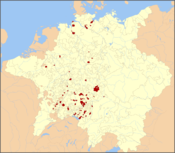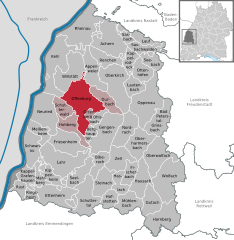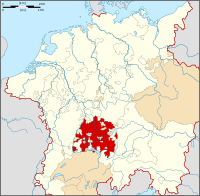- Offenburg
-
Offenburg is also the German name of Baia de Arieş in Romania.
Offenburg 
Coordinates 48°28′15″N 7°56′27″E / 48.47083°N 7.94083°ECoordinates: 48°28′15″N 7°56′27″E / 48.47083°N 7.94083°E Administration Country Germany State Baden-Württemberg Admin. region Freiburg District Ortenaukreis Lord Mayor Edith Schreiner (CDU) Basic statistics Area 78.39 km2 (30.27 sq mi) Elevation 163 m (535 ft) Population 59,215 (31 December 2010)[1] - Density 755 /km2 (1,956 /sq mi) Other information Time zone CET/CEST (UTC+1/+2) Licence plate OG Postal codes 77601–77656 Area code 0781 Website www.offenburg.de Imperial City of Offenburg
Reichsstadt OffenburgFree Imperial City of the Holy Roman Empire before 1240–1803  →
→Capital Offenburg Government Republic Historical era Middle Ages - First documentary
mention
1148- Gained Reichsfreiheit before 1240 - City razed in
Nine Years' War
1689- Became Badish fief 1701–71 - Ceded to Baden 1803 Offenburg is a city located in the state of Baden-Württemberg, Germany. With about 60,000 inhabitants, it is the largest city and the capital of the Ortenaukreis.
Offenburg also houses University of Applied Sciences Offenburg. Offenburg has a station on the Rhine Valley Railway between Karlsruhe and Basel.
Contents
Geography
Offenburg is located near the Rhine between Karlsruhe and Freiburg. The French city of Strasbourg lies directly west across the Rhine. Offenburg lies at the mouth of the Kinzig river valley. The Kinzig flows out of the Black Forest and meets the Rhine near Kehl.
History
The city is first mentioned in historical documents dating from 1148. By 1240 Offenburg had already been declared a Free Imperial City. The city was nearly totally destroyed in the Nine Years War. In 1803 Offenburg lost its status as a Free City and fell under the rulership of the Grand Duchy of Baden.
During the outbreak of the Revolutions of 1848, the "Offenburger Program" which contained thirteen demands "in the name of the people of Baden" was announced at the Salmen Inn on 12 September 1847. This was the first democratic demand in Germany. Along with the Karlsbad Resolves, the Offenburger Program demanded basic and human rights as well as freedom of the press and a progressive income tax structure. On 19 March 1848 the demands were confirmed by the 20,000 member Offenburg Peoples' Assembly.
Government
Mayors
- Gustav Rée (1945–49)
- Karl Heitz (1949–75)
- Martin Grüber (1975–92)
- Dr Wolfgang Bruder (1992–2002)
- Edith Schreiner (since 2003)
Representatives to the Federal Parliament
- Dr Wolfgang Schäuble (CDU)
Economy
Offenburg is home to Hubert Burda Media, a large printing and publishing company.
Culture and attractions
There are several historical attractions in Offenburg including:
- The Salmen Inn
- The Capuchin Monastery
- The Ritterhaus, a 1784 manor-house that has been converted into the city archives and museum
- The Jewish Bath (Mikwe): a bathhouse belonging to the city's historical Jewish community; it was held to be medieval, but recent research suggests it may be from the 16th or 17th century[2]
- The former Royal Palace (Königshof) built by Michael Ludwig Rohrer, now the Police station
People
- Kurt Baschwitz, Jewish journalist
- Atika Bouagaa, female volleyball player
- Burda family
- Aenne Burda, an honorary citizen
- Franz Burda I. (Franz Burda), founder of the Hubert Burda Media, an honorary citizen
- Hubert Burda, an honorary citizen
- Artur Dinter, lived here
- Hans Furler, lived here
- Johann Hofer, lawyer, lived here
- Michael Kaeshammer, boogie-woogie pianist, vocalist, composer, arranger
- Otto Kumm, lived here
- Dirk von Lowtzow
- Georg Monsch, an honorary citizen
- Lorenz Oken
- Franz von Roggenbach, an honorary citizen
- Felix Roth, football player
- Hanns-Martin Schleyer, manager, employer and industry representative
- Emil Sutor, sculptor
- Jürgen Todenhöfer, former judge, author, business executive, and former MP
- Hermann Vallendor, WWI German Ace, Jagdstaffel Boelcke
- Martin Wagner, football player
International relations
Offenburg is twinned with:
Notes
- ^ "Bevölkerung und Erwerbstätigkeit" (in German). Statistisches Landesamt Baden-Württemberg. 31 December 2009. http://www.statistik-bw.de/Veroeffentl/Statistische_Berichte/3126_10001.pdf.
- ^ "Offenburger Judenbad jünger als angenommen (Offenburg Jewish Bath younger than expected)" (in German) (PDF). Amtsblatt der Stadt Offenburg (Official Journal of the town of Offenburg). http://www.offenburg.de/scripts/download.php?key=3b550fde53bb&file=/dynamic/presse/offenblatt/c0f7fe26ed198ad3.pdf&name=offenblatt_240104. Retrieved 28 February 2010.
External links
- (English) Offenburg's Official Website
- (German) Information about and images
- (German) Messe Offenburg-Ortenau (fair Offenburg-Ortenau)
- (German) Webcam over the Burda-Tower
Free Imperial Cities of the Holy Roman Empire As of 1792 Aachen · Aalen · Augsburg · Biberach · Bopfingen · BremenH · Buchau · Buchhorn · CologneH · Dinkelsbühl · DortmundH · Eßlingen · Frankfurt · Friedberg · Gengenbach · Giengen · GoslarH · HamburgH · Heilbronn · Isny · Kaufbeuren · Kempten · Kessenich · Leutkirch · Lindau · LübeckH · Memmingen · Mühlhausen · MülhausenD, S · Nordhausen · Nördlingen · Nuremberg · Offenburg · Pfullendorf · Ravensburg · Regensburg · Reutlingen · Rothenburg · RottweilS · Schwäbisch Gmünd · Schwäbisch Hall · Schweinfurt · Speyer · Überlingen · Ulm · Wangen · Weil · Weißenburg in Bayern · Wetzlar · Wimpfen · Windsheim · Worms · Zell
Free Imperial Cities as at 1648 Cities that lost Imperial immediacy or gained independence before 1792 BaselS · BernS · Besançon · Brakel · Cambrai · Diessenhofen · Donauwörth · Duisburg · Düren · Gelnhausen · HagenauD · Herford · KaysersbergD · KolmarD · Konstanz · LandauD · Lemgo · LucerneS · Mainz · Metz · MunsterD · ObernaiD · Pfeddersheim · Rheinfelden · RosheimD · St. GallenS · Sarrebourg · SchaffhausenS · Schmalkalden · SchlettstadtD · SoestH · SolothurnS · Straßburg · Toul · TurckheimD · Verden · Verdun · Warburg · Weißenburg in ElsaßD · ZürichSD: Member of the Décapole. H: Member of the Hanseatic League. S: Member or associate of the Swiss Confederacy.Important cities and touristic sites in  Germany: Greater region of Freiburg (Breisgau–Black forest–High Rhine)
Germany: Greater region of Freiburg (Breisgau–Black forest–High Rhine)Major cities Other touristic sites Landscapes Breisgau · Feldberg · Hölle Valley · Kaiserstuhl · Schauinsland · Black forest · Triberg Waterfalls · River WutachNeighborhood Towns and municipalities in Ortenau (district) Achern | Appenweier | Bad Peterstal-Griesbach | Berghaupten | Biberach | Durbach | Ettenheim | Fischerbach | Friesenheim | Gengenbach | Gutach | Haslach | Hausach | Hofstetten | Hohberg | Hornberg | Kappel-Grafenhausen | Kappelrodeck | Kehl | Kippenheim | Lahr | Lauf | Lautenbach | Mahlberg | Meißenheim | Mühlenbach | Neuried | Nordrach | Oberharmersbach | Oberkirch | Oberwolfach | Offenburg | Ohlsbach | Oppenau | Ortenberg | Ottenhöfen im Schwarzwald | Renchen | Rheinau | Ringsheim | Rust | Sasbach | Sasbachwalden | Schuttertal | Schutterwald | Schwanau | Seebach | Seelbach | Steinach | Willstätt | Wolfach | Zell am HarmersbachCategories:- Towns in Baden-Württemberg
- Former republics
- Former countries in Europe
- States of the Holy Roman Empire
- City-states
- Imperial free cities
- States and territories established in the 13th century
- States and territories disestablished in 1803
- Ortenaukreis
- Historic Jewish communities
Wikimedia Foundation. 2010.





